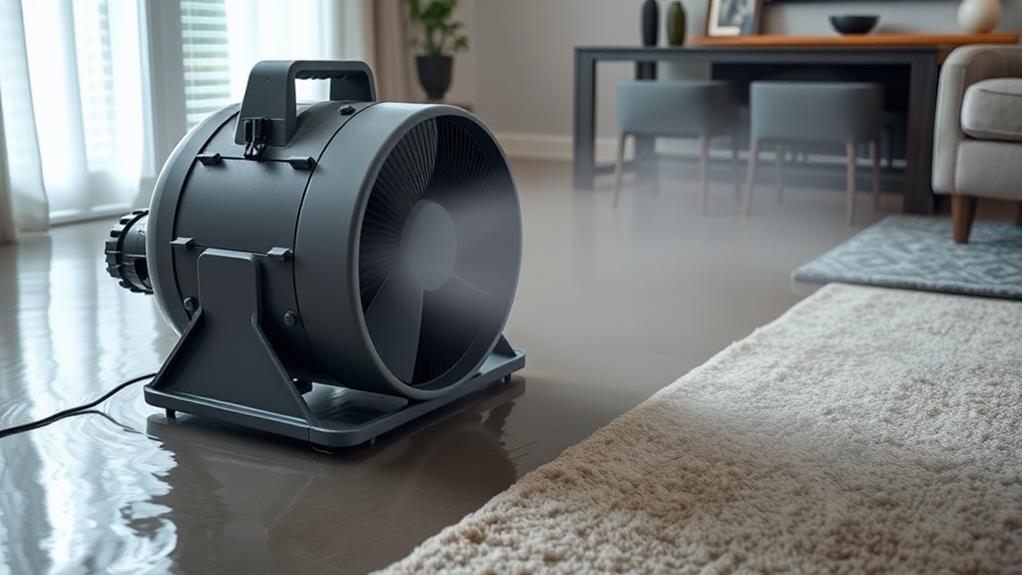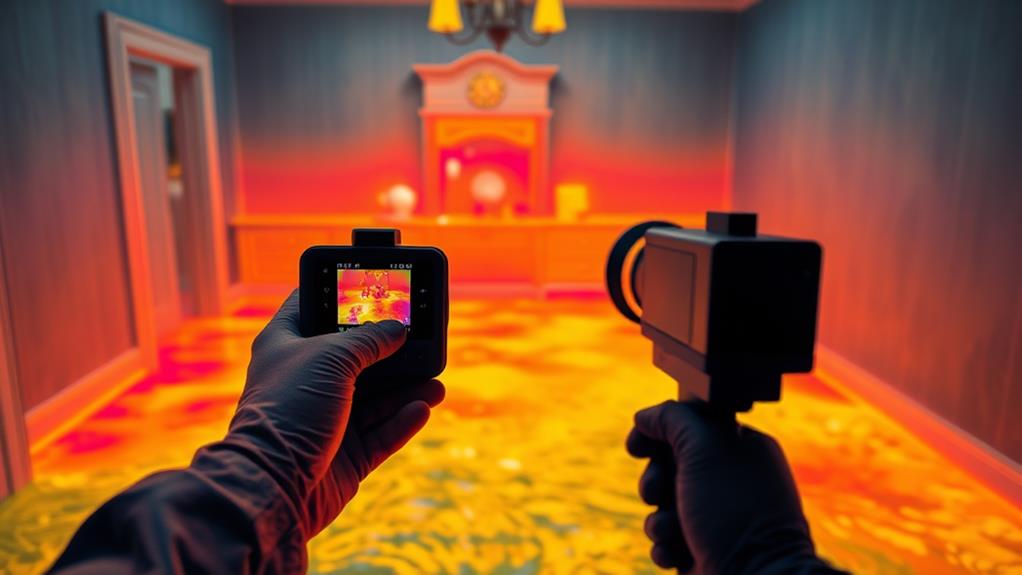Innovative tools have revolutionized the management of indoor standing water, offering efficient solutions for extraction, detection, and restoration. High-powered water extraction pumps rapidly remove large volumes of water, while advanced moisture detection devices identify hidden dampness. Rapid drying air movers and specialized dehumidification systems accelerate the drying process, preventing further damage. Thermal imaging cameras provide non-invasive moisture detection, enabling precise targeting of affected areas. Water-resistant restoration materials offer long-term protection against future water intrusion. Smart water leak detectors provide early warnings, potentially preventing extensive damage. These cutting-edge tools significantly improve the speed and effectiveness of water damage mitigation, with even more advanced solutions on the horizon.
High-Powered Water Extraction Pumps

High-powered water extraction pumps are essential tools for efficiently removing large volumes of standing water from indoor spaces. These powerful devices can rapidly evacuate water from flooded basements, crawl spaces, and other affected areas, minimizing structural damage and preventing mold growth. Designed for heavy-duty use, these pumps typically feature robust motors capable of moving hundreds or even thousands of gallons per hour.
Most high-powered extraction pumps are submersible, allowing them to be placed directly in the standing water for maximum effectiveness. They often come equipped with float switches that automatically activate the pump when water levels rise and shut it off when the area is cleared. Some models incorporate debris-handling capabilities, enabling them to process small solids without clogging.
For professional water damage restoration teams, truck-mounted extraction units offer even greater power and capacity. These systems can handle multiple hoses simultaneously, making them ideal for large-scale commercial or industrial flood mitigation projects. When selecting a water extraction pump, consider factors such as flow rate, head lift, and power source compatibility to ensure optimal performance in specific flood scenarios.
Advanced Moisture Detection Devices
Advanced moisture detection devices play a crucial role in identifying and assessing water damage in indoor environments. These sophisticated tools utilize various technologies to detect and measure moisture levels in materials such as walls, floors, and ceilings. Thermal imaging cameras, for instance, can reveal temperature differences caused by hidden moisture, allowing technicians to pinpoint problem areas without causing damage to surfaces.
Moisture meters are another essential tool in the arsenal of water damage professionals. These devices come in two main types: pin-type meters, which use metal probes to measure electrical resistance in materials, and pinless meters, which use electromagnetic sensors to detect moisture content. Both types provide accurate readings that help determine the extent of water damage and guide drying strategies.
Hygrometers are also valuable for measuring relative humidity in affected areas. By monitoring air moisture levels, technicians can assess the effectiveness of drying equipment and adjust their approach accordingly. Some advanced moisture detection devices combine multiple functionalities, integrating thermal imaging, moisture metering, and hygrometry into a single unit, streamlining the assessment process and improving overall efficiency in water damage restoration efforts.
Rapid Drying Air Movers

Rapid drying air movers are essential tools in the water damage restoration process, designed to accelerate evaporation and reduce drying times. These powerful devices circulate large volumes of air across wet surfaces, promoting faster evaporation of moisture from floors, walls, and other affected areas. Air movers come in various sizes and configurations, including axial, centrifugal, and low-profile models, each suited for specific applications.
Axial air movers are ideal for covering large areas, while centrifugal units provide focused airflow for targeted drying. Low-profile models are designed to fit in tight spaces, such as under cabinets or in crawl spaces. Many modern air movers feature adjustable speeds and positions, allowing technicians to optimize airflow patterns for maximum efficiency.
When used in conjunction with dehumidifiers, air movers create a synergistic effect that significantly accelerates the drying process. This combination helps prevent secondary damage, such as mold growth and structural deterioration. Some advanced models incorporate built-in humidity and temperature sensors, enabling automated operation based on ambient conditions. Additionally, HEPA filtration options are available for improving indoor air quality during the restoration process, making rapid drying air movers indispensable tools for water damage mitigation professionals.
Specialized Dehumidification Systems
Specialized dehumidification systems complement rapid drying air movers in the water damage restoration process, offering targeted moisture removal capabilities. These systems are designed to extract excess humidity from the air, walls, and other surfaces, preventing secondary damage such as mold growth and structural deterioration.
Industrial-grade desiccant dehumidifiers are particularly effective in large-scale water damage scenarios. They use chemical agents like silica gel or activated alumina to absorb moisture from the air, even at lower temperatures.
For smaller residential applications, refrigerant dehumidifiers are often employed. These units cool the air to its dew point, causing water vapor to condense and collect in a reservoir.
Low-grain refrigerant (LGR) dehumidifiers represent a more advanced solution, capable of removing moisture from the air even when relative humidity levels are low. They achieve this by pre-cooling the air before it reaches the evaporator coils, allowing for more efficient water extraction. Some specialized systems also incorporate HEPA filtration to remove airborne contaminants, enhancing indoor air quality during the drying process.
When used in conjunction with proper ventilation and air movement, these dehumidification systems significantly accelerate the restoration of water-damaged environments.
Thermal Imaging Cameras

How do restoration professionals detect hidden moisture in walls, floors, and ceilings? Thermal imaging cameras have become an indispensable tool in water damage restoration efforts. These sophisticated devices use infrared technology to visualize temperature differences across surfaces, allowing technicians to identify areas of moisture accumulation that are not visible to the naked eye.
Thermal imaging cameras work by detecting infrared radiation emitted by objects. Since water-damaged areas tend to be cooler than dry areas due to evaporation, they appear as distinct color patterns on the camera's display. This enables restoration professionals to pinpoint the exact locations of water intrusion, even behind walls or under flooring.
The benefits of using thermal imaging cameras in water damage restoration are numerous. They allow for non-invasive inspection, reducing the need for destructive testing. These devices also improve efficiency by quickly scanning large areas, saving time and resources. Additionally, thermal imaging helps ensure that all affected areas are properly addressed, minimizing the risk of mold growth and structural damage. By providing a comprehensive view of moisture distribution, these cameras enable more accurate assessment and targeted remediation efforts.
Water-Resistant Restoration Materials
In the aftermath of water damage, selecting the right materials for restoration is crucial to prevent future issues. Water-resistant restoration materials have evolved significantly, offering improved durability and protection against moisture intrusion. These materials are designed to withstand prolonged exposure to water and humidity, reducing the risk of mold growth and structural deterioration.
One key category of water-resistant materials is moisture-resistant drywall, also known as greenboard. This specialized drywall contains additives that repel water and inhibit mold growth, making it ideal for bathrooms, kitchens, and other moisture-prone areas.
Water-resistant flooring options, such as luxury vinyl planks and tiles, provide a durable and waterproof surface that can withstand standing water without warping or deterioration.
Waterproof sealants and coatings play a vital role in protecting restored surfaces. These products create a barrier against moisture penetration, safeguarding walls, floors, and other vulnerable areas. Additionally, water-resistant insulation materials, like closed-cell spray foam, offer superior moisture resistance and thermal performance compared to traditional fiberglass insulation. By incorporating these innovative materials into restoration projects, property owners can significantly enhance their buildings' resilience to future water damage incidents.
Smart Water Leak Detectors

Smart water leak detectors have burst onto the scene as invaluable tools for preventing and mitigating water damage in homes and buildings. These devices utilize advanced sensors and wireless technology to detect moisture and alert property owners to potential leaks before they escalate into major issues. By providing early warnings, smart leak detectors enable swift action to minimize damage and reduce repair costs.
Most smart water leak detectors are compact, battery-powered devices that can be placed near potential leak sources such as water heaters, washing machines, and under sinks. When moisture is detected, the device sends instant notifications to the user's smartphone or other connected devices. Some advanced models can even automatically shut off the main water supply to prevent further damage.
Many smart leak detectors integrate with home automation systems, allowing for seamless monitoring and control. Features like temperature sensing can help prevent frozen pipes, while historical data analysis can identify patterns and predict potential issues. With their ability to provide real-time alerts and proactive protection, smart water leak detectors are becoming essential components of modern property management and maintenance strategies.
Frequently Asked Questions
How Can I Prevent Mold Growth After Water Damage?
To prevent mold growth after water damage, immediately remove excess water, thoroughly dry affected areas within 24-48 hours, use dehumidifiers and fans, clean surfaces with appropriate disinfectants, and maintain proper ventilation. Consider professional assistance for extensive damage or hidden moisture.
What Safety Precautions Should I Take When Dealing With Indoor Standing Water?
Like navigating treacherous waters, dealing with indoor standing water requires caution. Wear protective gear, including waterproof boots and gloves. Shut off electricity, avoid contact with contaminated water, and use proper disinfection methods to prevent health hazards.
Are There Any DIY Methods for Removing Small Amounts of Standing Water?
For small amounts of standing water, DIY methods include using towels, mops, or sponges to absorb the liquid. A wet/dry vacuum can be effective for larger areas. Buckets and pumps may also be useful for manual water removal.
How Long Does It Typically Take to Fully Dry Out a Water-Damaged Area?
In a recent residential flood, drying time varied by room. Typically, fully drying a water-damaged area takes 3-5 days, depending on factors like humidity, airflow, and materials affected. Professional equipment can expedite the process significantly.
Can Standing Water Cause Structural Damage to My Home's Foundation?
Yes, standing water can cause significant structural damage to your home's foundation. It can lead to soil erosion, foundation settling, cracks, and weakening of the overall structure. Prolonged exposure may result in costly repairs and compromised stability.
Conclusion
In a world where indoor floods threaten to transform living rooms into impromptu swimming pools, these innovative tools stand as beacons of hope in a sea of despair. From pumps that could drain the Titanic to dehumidifiers that could dry the Amazon, modern technology has armed humanity with an arsenal against the aquatic invasion. As moisture detection devices hunt down every last droplet with the tenacity of a bloodhound, homeowners can rest easy, knowing their domiciles will remain gloriously arid sanctuaries.

